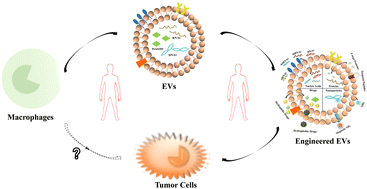Engineering extracellular vesicles derived from macrophages for tumor therapy: a review
Abstract
In medicine, surgical operation, radiotherapy, chemotherapy and other treatment methods have achieved tumor treatment, but the treatment effect of these methods isn’t particularly ideal, and the tumor cannot be completely cured. Compared with traditional treatments, immunotherapy using nanoparticles can achieve lasting efficacy. Macrophages are important immune cells in living organisms, they play a key role in innate immunity or adaptive immunity. Tumor-associated macrophages (TAMs) are the key link between tumor immunosuppression and tumor progression, which play a vital role in the process of tumor occurrence, development, invasion and metastasis. Although many studies have shown that changing macrophage phenotype plays a role in tumor treatment, these treatments also cause greater immune rejection. Macrophage-derived extracellular vesicles (EVs) are small vesicles with nanoscale bilayer membrane structure secreted by macrophages in an organism. They can carry bioactive substances, such as proteins, lipids and nucleic acids containing parental cell information and mediate the information transmission among cells. However, EVs also have some disadvantages, such as low yield, insufficient targeting and too many ineffective components. Engineering EVs can be particularly useful in ameliorating these problems. Therefore, engineering EVs derived from macrophages can be used in tumor therapy. This paper briefly reviews the application of macrophage-derived EVs in tumor therapy.

- This article is part of the themed collections: Recent Review Articles and Editor’s Choice: Kaushik Chatterjee


 Please wait while we load your content...
Please wait while we load your content...